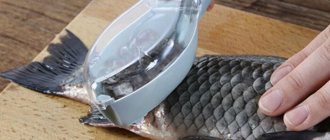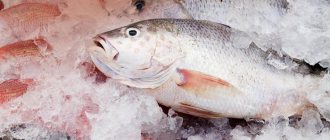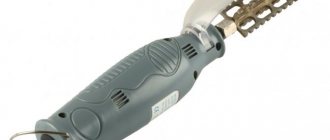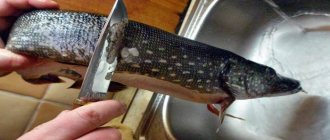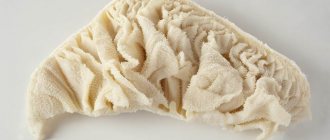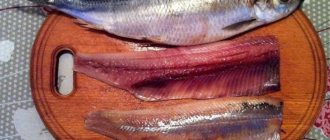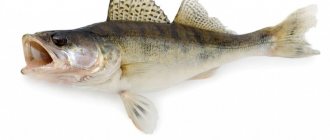Do you love perch fish, but are you afraid that it will be difficult to clean? Read the article, in it you will find several ways to remove scales from it.
River perch is a very tasty and healthy fish. It makes incomparable fish soup and many other dishes. What may stop you from buying fresh or frozen perch is its small, closely spaced scales, as well as extremely sharp fins. Cleaning takes a long time, often hurts your hands, and leaves the kitchen a complete mess. This hassle discourages many from cooking perch at all. But we offer you several ways to help you cope with this task.
How to clean scales from fresh river perch easily and quickly yourself: methods
If you have purchased fresh bass, consider which method of cleaning it is best for you.
IMPORTANT: We will please you right away: if you want to smoke fish or use it for the first addition to fish soup, you can skip the cleaning procedure. In these cases it is not required.
Perch is a very healthy and tasty fish.
If you have a fisherman in your family, and he has caught a catch of river perch, do not put off cleaning them: the fresher the fish, the easier it is to rid it of its scales while it is soft and not sticky. And you can freeze already prepared carcasses for future use. Before you move on to the cleaning process, consider where you should do it. Many people prefer to do this right in the kitchen sink, which can then be easily washed to remove dirt and odors. If it is more convenient for you on the table, remove everything unnecessary from it, cover the surface with cling film, paper or regular newspaper sheets. And you should definitely have a separate cutting board for fish!
Board with fish clamp.
IMPORTANT: If you like to eat perch or other fish, buy a special board with clamps for it, it will make your work easier. Also purchase scissors and scrapers for cleaning carcasses. This can be done at any hardware store or on Aliexpress in this section of the catalog.
Scraper for cleaning perch and other fish from Aliexpress.
So, no matter which method you choose from the ones described below, start with this:
- wash the fish
- put on work gloves
- place the perch on a cutting board, grab the head and tail
- stretch the carcass until you hear the crunch of the fins
- take kitchen scissors and cut off all the fins of the fish
- cut off the fish's head and tail fin
Removing fins from perch.
Preparing a perch carcass, removing scales and skin.
IMPORTANT: Be sure to wear gloves when working with a perch carcass, even if you are not a girl with delicate hands, but a strong man. Firstly, it will slip in bare hands and will be inconvenient to clean. Secondly, the fins can leave deep cuts on the skin.
Choose one of the methods for cleaning fresh perch from scales that you find most convenient:
- with a special knife or homemade brush
- grater
- water and vinegar
- boiling water
- salt
Next, each method will be discussed in more detail.
The final step in preparing the carcass is removing the entrails.
Tool
A kitchen knife is a familiar and traditional tool that all housewives are used to cleaning fish. For safety reasons, if you have never cleaned scales or have not yet gained experience in this difficult task, then it is better to clean with the blunt side of a knife.
There are also special tools, somewhat similar in design to scrapers. These tools are safe and easy to use. Sometimes you have to clean fish with hard scales (for example, perch, ruffe and the like), in such cases it is recommended to use special graters.
An empty tin can also makes a great grater. You just need to fill the holes on the inside of the jar, so that a kind of grater, sharp bulges, are formed at the bottom of the jar.
How to peel frozen sea bass easily and quickly from scales yourself: methods
A frozen river or sea bass carcass can be cleaned in the same way as fresh fish, with a knife, grater, salt and boiling water. There is another method that is suitable in this case - try to remove the scales along with the skin, after freezing it will be very easy.
- Rinse the frozen carcass in warm water. Or dip it in boiling water for a few seconds. This is necessary so that the skin of the fish thaws, but the inside of the carcass remains frozen.
- Remove all of her fins.
- Cut off the head and tail of the perch.
- Carefully make cuts in the skin of the fish on its back and belly.
- Take a sharp knife, hook the skin of the fish in the area where the head is cut and gently pull it towards the tail.
- Remove the scales along with the skin from one side and then the other.
Removing scales from frozen perch along with the skin.
IMPORTANT: You can also peel fresh perches along with their skins. To do this, they are frozen in the freezer for an hour. This method is the easiest and least dirty. But if you want to fry the fish until golden brown, it is not suitable for you.
What is better to clean fish with a spoon or karcher
To reduce the number of scales flying around the kitchen, you can clean the fish with a spoon. The cleaning process is the same as using a knife or grater, but the advantage is that most of the scales remain inside the concave part of the spoon.
We recommend reading:
How to rent an apartment while traveling
At the same time, it is cleaned quite simply and relatively quickly. For greater convenience in this case, it is better to place the fish on the table and hold it with your hand. By the way, even if it is slippery and heavily covered with mucus, this will hardly interfere with its cleaning using this method, perhaps only slowing down the process a little.
Another unusual method invented by motorists is the use of a Karcher portable car wash. The fact is that water from the hose is supplied under high pressure. If you press the fish to a hard surface, for example, to the ground, and direct a jet at it, the scales themselves will fly out from under its pressure.
But rest assured that you will be guaranteed a fountain of scales mixed with splashes. It may not be possible to completely clean the fish in this way, but most of it can definitely be freed from the outer cover, and the remaining scales can be removed manually. What is better to use in this case? Hard to tell. Everyone chooses a method at their own discretion.
Some people want less dirt, while others want less fiddling with their hands. The final choice of cleaning tool will depend on this.
Author of the publication
offline 3 years
Nika
18
I am interested in hiking and traveling, photography and videography. I have been going hiking since childhood. The whole family went and went - sometimes to the sea, then to the river, to the lake, to the forest. There was a time when we spent a whole month in the forest. We lived in tents and cooked over fires. This is probably why I am still drawn to the forest and, in general, to nature. I travel regularly. About three trips a year for 10-15 days and many 2 and 3 day hikes.
Comments: 0Publications: 668Registration: 10/23/2018
Nika Survival in the wild, Nutrition in the wild, Articles
How to quickly remove scales from a perch with salt: description, photo
Didn't have time to clean your freshly caught perch and bought them at the store? Then, before cleaning the scales, go through the preparatory stage.
- Rinse the carcasses, do not cut off the fins.
- Place the fish on a tray sprinkled with salt. Roll it with salt on all sides. Salt should be coarse, rock salt.
- Leave the perch like this overnight.
- In the morning, rinse the carcasses; the scales on them should soften and slightly move away from the skin. The procedure for preparing carcasses and removing scales should become easier.
Salt softens the perch's scales and makes them easier to peel.
Cleaning procedure
Here is a step-by-step algorithm of actions.
- Remove the dorsal fin using scissors. Grab it with a cloth and tear it off.
- Remove scales.
- Take out the giblets.
- Rinse the fish with water several times.
- Remove any remaining blood.
- Cut the carcass into portions or fillet it.
- Place in a colander to remove excess liquid.
How to quickly remove scales from a perch with a knife: description, photo
If you have a special knife or fish scraper, use it:
- fix the prepared perch carcass on the board
- run a scraper along one side of it, hooking the scales against their growth
- turn the carcass over, clean it on the other side
- rinse the carcass under running water
Cleaning perch with a knife.
If you don't have a special scraper, you can make your own:
- from a canning lid, making notches in it
- from beer bottle caps, bolting them to a wooden strip or handle, such as a paint brush
Homemade scrapers for cleaning fish.
Do I need to clean fish?
The most tedious and monotonous process after fishing is cleaning the fish. I want to quit this dirty business, and every now and then the question arises in my head: is it really necessary to clean fish? Our answer may surprise you, but no, this is not always necessary. For example, some types of fish are cooked directly in the scales: thus, it retains more useful microelements, which it is known to be very rich in. However, the question of how to cut fish is urgent, so this article is for us.
They clean it immediately before serving, and filter the broth or broth in which it was stewed through a sieve. An excellent way out of a situation when you don’t want small flakes scattered all over the kitchen. But this method is not always acceptable, and most fishermen still prefer to clean the fish first, and only then start cooking it.
How to quickly remove scales from a perch using a grater: description, photo
Instead of a scale scraper, you can use an ordinary metal grater. Walk it against the growth of scales. If you are uncomfortable holding a bulky grater in your hands, ask your husband to design a device for you - attach part of a small grater blade to a wooden handle, as in the picture below.
Cleaning perch with a grater.
A grater scraper for removing scales from a perch.
How to remove offal
The process of removing giblets from fish frightens many, although there is nothing scary about it. Everything is quite simple and fast, the main thing is to follow the well-known recommendations and tips:
- You need to clean the fish and remove the giblets on the same day, or better yet, at the same time.
- You will definitely need a cutting board. In order not to contaminate the board, you can put a bag on it or put a piece of paper on top.
- The cut is made in the direction from the head to the tail, while you need to hold the fish with its belly down.
- The contents are easily removed using a knife or spoon.
- The black film on the walls of the belly also needs to be cleaned.
- Now all that remains is to rinse the fish and its belly under running water.
How to quickly clean scales from large and small perch yourself: what is the difference between cleaning?
Although the scales of small perches are not as rough as those of large specimens, it is very difficult to peel without damaging the skin. Most likely, you won't succeed.
Small perches for the first laying on the ear do not need to be cleaned of scales at all.
Gutting
The choice of gutting method will depend on what kind of dish you want to make. Usually the giblets are removed through an incision in the abdomen. After making an incision, you need to carefully pull out the liver and gall bladder. Try not to squeeze them to avoid crushing them. Otherwise, the bile will leak out and spoil the taste of the meat. If this situation cannot be avoided, you need to quickly cut off the damaged areas or treat them with salt.
There are a lot of bones in the carp. To remove them, it is advisable to make an incision on the back to the vertebrae. After this, cut the carcass lengthwise, moving from head to tail. Separate the tail. If you plan to bake the crucian carp whole, remove the giblets through the cut made under the head. Remove the gills. Place the filling inside. You can also remove the head along with its entrails, clean out the cavity and rinse it.
Using boiling water
The simplest and most inexpensive cleaning method. It is necessary to boil a small amount of water (so that it covers the fish completely when submerged) in a saucepan or other container. Immerse the fish carcass in the hot water turned off for a couple of minutes. After this, remove and dry with a paper towel or napkins. The scales will be soft and pliable, so they can be easily scraped off with a spoon. The main thing is not to overcook the fish in the water, otherwise it will cook.
fish cleaning knife
The fastest option
If you plan to make roasts, cutlets, dumplings, pie filling from pike, or get layers of fillet for some recipe, you don’t need to save the skin.
In this case, it is simply removed along with the scales in a few minutes. Before cleaning the pike for cutlets, you need to make an incision along the back and pry it with a knife. Place your index finger under it and, moving forward, separate it from the pulp. After this, the fillet is removed from the bones and washed well.
Note! You can also cut the fish lengthwise into two layers. Remove the backbone and trim the flesh from the rib bones and skin.
Elimination of specific odor
Even with proper cleaning and complete removal of the skin, catfish meat still has a faint muddy aroma. You can completely get rid of the smell of mud by marinating the fish before preparing dishes from it. For pickling, use lemon juice or dry white wine.
The carcass, cut into pieces, is placed in a suitable container, and the juice from the cut lemon is squeezed onto the meat. You can use orange or lime. If wine is used to prepare the marinade, the pieces are moistened with alcohol. There is no need to pour too much liquid, just drizzle the fillet well. After moistening with marinades, leave the meat for 20-25 minutes. You can rinse it with water before cooking.
To eliminate the muddy taste, fresh milk is also used. It will take a long time to soak the pieces of somyat in it. The process takes at least 3 hours, but after this treatment the meat becomes tender and has a special taste.
To remove the smell of mud, spices are traditionally added when preparing catfish dishes. Black pepper goes best with fish. It is used in ground or whole form. Allspice (Jamaican) pepper, nutmeg, and fenugreek go well with catfish. You can put fresh dill and parsley, bay leaf and onion in your ear.
Filleting
They begin filleting the catfish carcass only after complete cleaning. Most often, the skin is also removed before cutting. The prepared fish is placed on its side to remove the head. Then a transverse incision is made at the base of the caudal fin. You need to cut through all the muscles on 1 side up to the spinal bone, but do not cut it.
Then they begin to trim the meat, holding the knife parallel to the table. For large fish, this is done in stages, gradually deepening the cut and carefully removing the layer from the spine and bones from the upper and lower sides. Having reached the beginning of the rib part, they continue to trim the meat only on the back, leaving the ribs intact. When the cut reaches the end, the knife is turned parallel to the ridge and the fillet is cut from the rib part, moving the blade from the spine to the edges of the cut on the belly.
The cut fillet does not contain small bones. If the meat was removed from the ribs carelessly, several bones will remain on the surface of the abdominal wall on the inside. They must be removed individually.
The half with the vertebral bone is turned over with the flesh facing up, the meat is cut to the spine and the procedure is repeated.
The severed head, ridge with caudal fin and skin do not need to be thrown away. They are used to prepare a delicious broth for fish soup or aspic, and the skin is now considered a fashionable decoration and flavoring addition to fish dishes. It is cut into thin “noodles” and fried in oil.
Criteria for choosing fresh chum salmon
You should not purchase the product from street vendors; it is better to give preference to supermarkets or stores selling fish and seafood. There, storage rules are observed, all necessary documents are available, and a receipt is issued, which serves as a guarantee of the quality of chum salmon.
You need to inspect the chilled fish, press your finger on the carcass in the abdomen area - it should be elastic and immediately straighten. Bright red or pink gills and clear eyes with a clearly visible pupil indicate the freshness of chum salmon. When cutting, the meat of a high-quality carcass will be dense, with whole fibers.
Signs of poor quality fish:
- dry, brittle scales;
- excess mucus;
- soft, inelastic belly with greenish spots;
- gray, darkened gills;
- unpleasant odor;
- shrunken, sunken, cloudy eyes.
Useful properties of chum salmon
100 g of fish pulp contains about 127 kcal, 24 g of proteins and 10 g of fat.
The chemical composition of chum salmon contains vitamins A, E, C, PP, D, group B, and polyunsaturated omega fatty acids. When a person regularly consumes tasty and healthy dishes, his body is saturated with minerals: calcium, potassium, phosphorus, magnesium, sulfur, fluorine, sodium, manganese, iron, iodine, zinc, selenium, copper, molybdenum. This improves the condition of the heart and blood vessels, bone and muscle tissue, and reduces the risk of strokes, heart attacks, and atherosclerosis. Doctors, nutritionists, and scientists recommend introducing fish into your diet at least twice a week. Return to list

